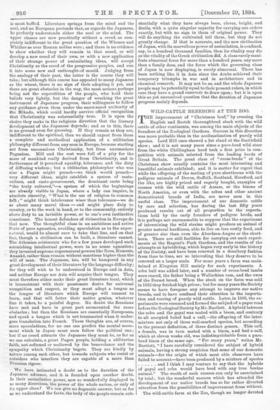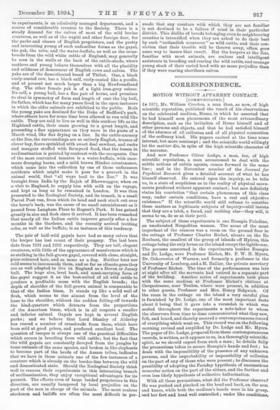WILD-CATTLE BREEDING AT THE ZOO.
THE improvement of "Christmas beef," by crossing the English and Scotch thoroughbred stock with the wild cattle of other continents, was among the main objects of the founders of the Zoological Gardens. Success in this direction was more probable than in the acclimatisation of purely wild species. Lord Hill once showed a fat eland at the Smithfield show ; and it is not many years since a pure-bred wild steer from the white Chillingham herd took a first prize in com- petition with animals selected from the leading herds of Great Britain. The great class of " cross-breds " at the Christmas show usually contains the most interesting and beautiful animals exhibited; and it is matter for regret that while the offspring of the mating of pure shorthorns with the pedigree animals of Devon, Suffolk, Scotland, Hereford, and the like, are highly prized and eagerly bought, examples of crosses with the wild cattle of Assam, or the bisons of North America, or even with the zebus and other ancient domesticated breeds of India, are never seen in this useful class. The improvement of our domestic cattle by care and selection, has during the last fifty years produced results out of all proportion to the expecta- tions held by the early founders of pedigree herds, and it is perhaps not unreasonable to suppose that the experiment of intermixing the wild strains might produce an animal of greater natural hardiness, able to live on less costly food, and of greater size than even the Aberdeen-Angus or the short- horn. There are still facilities for carrying out such experi- ments at the Regent's Park Gardens, and the results of the attempts at hybridising, which began very early in the history of the Society, and have been renewed in a desultory fashion from time to time, are so interesting that they deserve to be renewed on a larger scale. For some years a farm was main- tained at Kingston Hill mainly for such experiments. A zebu bull was added later, and a number of cross-bred lambs were reared, the father being a Wallachian ram, and the ewes of the Dorset breed. When the stock on the farm was sold in 1832 they fetched high prices; but for many years the Society seems to have foregone any attempt to improve our native breeds, and to have confined their attention to the importa- tion and rearing of purely wild cattle. Later, in 1868, the ex- periments were resumed and formed the subject of a paper read before the Zoological Society by Mr. Bartlett. A hybrid between the zebu and the gayal was mated with a bison, and contrary to all accepted belief had a calf,—the offspring of the inter- mixture not only of three well-marked species, but according to the present definition, of three distinct genera. This calf, a female, was in turn mated with a bison, and had a calf, which at eleven weeks old, was indistinguishable from a pure- bred bison of the same age. "For many years," writes Mr. Bartlett, "I have carefully considered the subject of hybrid animals, having a strong suspicion that some of our domestic animals—for the origin of which most able observers have failed to account—have been produced by a mixture of species
and I think I may venture to say that the hybrids of gayal and zebu would have bred with any true bovine animal." The worth of such crosses can only be ascertained by trial ; but the wonderful success which has attended the development of our native breeds has so far rather diverted attention from the possibilities of improvement from without.
The wild-cattle farm at the Zoo, though no longer devoted
to experiments, is an admirably managed department, and a source of considerable revenue to the Society. There is a steady demand for the calves of most of the wild bovine creatures, as well as of the wapiti and other foreign deer, for the parks and chases of English proprietors, and the pretty and interesting young of such unfamiliar forma as the gayal, the yak, the zebu, and the water-buffalo, as well as the cross- breeds from the wild white cattle of England, may generally be seen in the stalls at the back of the cattle-sheds, where anothers and young behave themselves with all the placidity and mildness of demeanour of English cows and calves. The yaks are of the domesticated breed of Thibet. One, a black curly-coated cow, has a black calf, curly-coated like a poodle, and at present not much larger than a big Newfoundland dog. The other female yak is of a light iron-grey colour. Its calf, a young bull, has a fine pair of horns, and promises to rival in symmetry of form and length of coat the big bull, its father, which has for many years lived in the open inclosure in which the older animals are exhibited to the public. Both the young yaks are destined for the Duke of Bedford's park, ,where others have for some time been allowed to run wild like cattle. They are said to live as well in this outdoor life as the Highland cattle, their coats growing to a great length, and presenting a fine appearance as they wave in the gusts of a March wind, like flax drying on a line. In the cattle-nursery at the Zoo, the surroundings are so entirely English, trusses of clover hay, floors sprinkled with sweet deal sawdust, and racks and mangers stuffed with farmyard food, that the lesson in acclimatisation is pointed by contrast with the occupants. One of the most contented inmates is a water-buffalo, with enor- mous drooping horns, and a mild brown Hindoo countenance, which came into the collection by one of those unforeseen accidents which might make it pass for a proverb in the animal world, that "all ways lead to the Zoo." It was brought from India by the Rajah of Bhownuggnr, when on a visit to England, to supply him with milk on the voyage, and kept as long as he remained in London. It was then presented to the Zoological Society, and its transit, in a small Parcel Post van, from which its head and neck stuck out over the horse's back, was the cause of no small astonishment as it passed from Langham Place to Regent's Park. It has gained greatly in size and flesh since it arrived. It has been remarked that nearly all the Indian cattle improve greatly after a few months in the Gardens, and the recently arrived trotting zebu, as well as the buffalo, is an instance of this tendency.
The pair of half-wild gayals have had so many calves that the keeper has lost count of their progeny. The last born date from 1891 and 1893 respectively. They are tall, elegant creatures, with little of the appearance of massiveness which is so striking in the full-grown gayal, covered with close, straight, puce-coloured hair, and as tame as a dog. Neither heat nor cold seems to incommode them, and so far as climate goes they are as well adapted to live in England as a Devon or Jersey bull. The huge size, level back, and meat-carrying form of the gayal suggest it as the best-suited of all wild cattle to produce a profitable cross with the English breeds ; the depth of shoulder of the full-grown animal is comparable to that of the Indian bison. It stands up like a solid wall of flesh, which seems to rise almost from the level of the knee to the shoulder, without the sudden falling-off towards the hind-quarters which detracts from the proportions of the American bison, which is in all respects a smaller and inferior animal. Gayals are kept in several English parks ; and we believe that Lord Stanley of Alderley has reared a number of crossbreds from them, which have been sold at good prices, and produced excellent beef. The question of temper is always one of the practical difficulties which occurs in breeding from wild cattle; but the fact that the wild gayals are constantly decoyed from the jungles by tame animals of the same species, and broken in like elephants to become part of the herds of the Assam tribes, indicates that we have in these animals one of the few instances of a ,creature which is already on the border-line between the wild and domesticated state. Should the Zoological Society think well to resume their experiments in this interesting branch of acclimatisation, they enjoy exceptional advantages for its pursuit. The efforts even of large landed proprietors in this direction, are usually hampered by local prejudice on the part of the men in charge of the animals. The most zealous etockmen and bailiffs are often the most difficult to per.
amide that any creature with which they are not familiar is not destined to be a failure if tried in their particular district. This dislike of breeds belonging even to neighbouring counties is intensified when they are asked to do their best by such "outlandish creatures" as wild cattle, and their con- viction that their trouble will he thrown away, often goes some way to insure that result. But the keepers at the Zoo, familiar with most animals, are zealous and intelligent assistants in breeding and rearing the wild cattle, and manage young stock of their varied herd with no more prejudice than if they were rearing shorthorn calves.



































 Previous page
Previous page